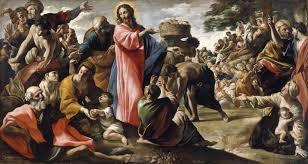Loaves & Fishes II

David Cowles
Jul 3, 2025
“So was the feeding of the 5,000 a miracle? Yes…and no!”
In an earlier post on this site, we ‘decoded’ the New Testament ‘miracle’ known as the Multiplication of Loaves & Fishes. We discovered that the New Testament (NT) accounts of two separate ‘multiplication events’ form a pattern which allows us to understand their deeper meaning.
So what’s the ‘answer’ to the riddle posed by the ‘multiplication’? Why, it’s the number 3 of course! What else could it be? (Discover that for yourself; just click on the link above.)
But these accounts raise a deeper question: “How’d he do it?” Of course, a simple answer is, “By the power of God who is omnipotent.” Now, if this answer fully satisfies you, you may not need to read on. But if you’re looking for a more heuristic explanation, please continue.
What is a miracle? Is it a suspension of the laws of physics? The intervention of a transcendent and omnipotent power? That’s the standard ‘explanation’…such as it is.
Or is it just a perfectly natural, but unusual, event? Folks who explain the Exodus as a rare confluence of unlikely meteorological conditions fall into this camp.
Or do ‘miracles’ provide us with a glimpse of an entirely physical reality that exists below the surface of conventional spacetime? (Like quantum mechanics, e.g.) In other words, can we retain the concept of the miraculous but reconcile it with materialism?
Folks like me who fall into this later camp do not intend to denigrate in any way the power of God. Rather, we defend it! We simply seek to preserve the ontological independence of the world as God created it.
What if the scrubbed and manicured world we call ‘home’ is just a surface, a region, an approximation or an idealization of a much more variegated universe in which many alternative states of affairs may apply? What if there is something about our cognitive apparatus that prompts us to see the phenomenal world as we do, even though it’s an over-simplified version of what’s real? Or what if the substructure of the universe itself is ‘Cloud Cuckoo Land’? (The Lego Movie )
Sidebar: Wikipedia says that someone who lives in Cloud Cuckoo Land, “thinks that completely impossible things might happen…” Yup, that’s us…modified to read: “thinks that infinitesimally probable things actually happen.” Etymologically, this concept derives from the medieval Cockaigne, a ‘land of plenty’.
Philosophically, the term first appears in Aristophanes’ play, The Birds (414 BCE), but it has appeared more recently in the philosophies of Schopenhauer and Nietzsche.
The ‘multiplication of loaves and fishes’ is a miracle because you are not supposed to be able to satisfy the appetites of 5,000 hungry pilgrims with just 5 loaves of bread and 2 fish. If a loaf of bread weighs a kilogram, then each pilgrim would receive one gram of bread. (A gram is roughly 1/25th of an ounce.) If this works, it’s even better than Atkins.
But of course it doesn’t work, at least not in the world we’re accustomed to. It doesn’t work because the volume of the ‘parts’ (5,000 crumbs = 5 kilograms) cannot exceed the volume of the ‘whole’ (5 loaves = 5 kilograms) and 1/25th of an ounce will not satisfy a hungry boy (or girl).
This is obviously true in the world as we know it (and in any world characterized by the Archimedean Property). But who died and made Archimedes boss of the universe? According to Nietzsche, God did! RIP
Suppose our everyday Archimedean world is just a special case of a much more flexible, non-Archimedean universe, where the quantitative relationship between a whole and its parts is no longer hardwired by the laws of arithmetic. (What’s the big deal? Zeno disproved those laws 2500 years ago!)
Breaking the bread (loaves) into individual portions, we create 5,000 disjoint morsels. In a non-Archimedean universe, the volume of the parts (morsels) can exceed the volume of the whole! In fact, even a single morsel can exceed the volume of the whole.
The morsels, considered together or apart, can contain more bread, potentially much more bread, than the 5 loaves from which they were crumbled. That was the case on a certain day on the northern shore of the Sea of Galilee 2,000 years ago. Not only did 5 loaves fill the bellies of 5,000 day trippers but the apostles were able to gather up 12 baskets of scraps at the end.
5,000 were fed and there was more left over than there was at the beginning. If only my household budget worked like that! (Perhaps it would if I followed NT economic principles.)
So was ‘the feeding of the 5,000’ a ‘miracle’? Yes…and no! It was certainly a manifestation of God’s power in the person of Jesus (you don’t routinely dip into the non-Archimedean substructure to solve your problems); but it did not violate any of the laws of (non-Archimedean) physics nor did it compromise the independence of the created world (Genesis 1).
***
"The Miracle of the Loaves and Fishes" (1624–25), oil on canvas by Giovanni Lanfranco, Italian, 1582–1647. 229 x 426 cm. Purchased in 1856.
https://www.aletheiatoday.com/thoughtswhileshaving/loaves-and-fishes
Do you like what you just read and want to read more Thoughts? Subscribe today for free!
- the official blog of Aletheia Today Magazine.







